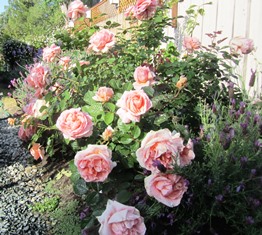A Rose Bush for Your Valentine?
If your sweetheart is a gardener, why not give a gift that keeps on giving? Instead of a single rose or a bouquet, consider giving a bare-root rose bush. A plethora of plants are arriving in garden centers now.
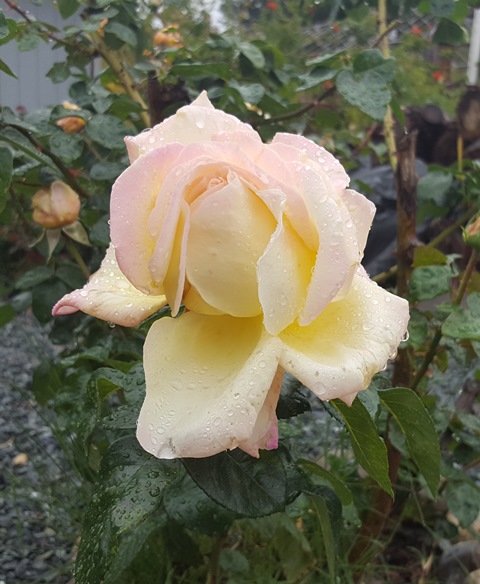
Many modern roses have been bred to bloom repeatedly throughout spring, summer, and fall, even into December in milder climates. With gorgeous single buds on tall stems or dazzling sprays of blooms, roses are the perfect cut flowers for indoor bouquets.
With the traditional “lover’s” day just around the corner, now is the time to decide on what type of rose bush to give your valentine. Bare-root season is the best time to purchase rose bushes. In a couple of months prices go up as unsold roses are re-potted in containers of soil with nutrients.
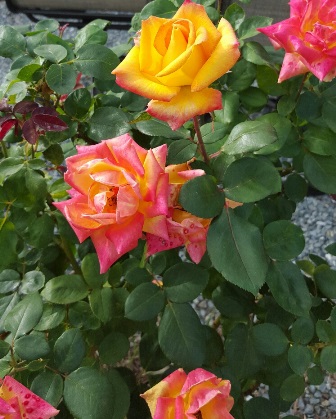
well-known “Ketchup & Mustard” floribunda
At the most basic level, roses are classified into three main categories: wild roses, old garden roses bred before 1867, and new roses bred or hybridized for modern gardens for fragrance, bloom size, color, and other desirable characteristics.
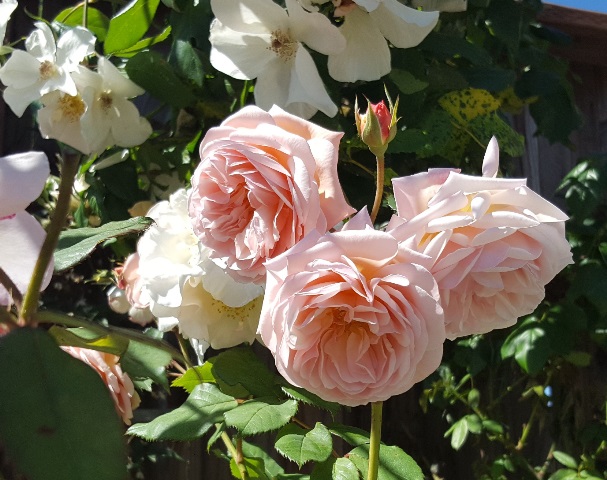
Before you buy, consider what characteristics you would like in a rose and choose a type that matches your purpose.
Modern varieties have been cultivated to produce roses to repeat bloom, bloom as single buds, or bloom in sprays. Some are fragrance-free; others offer a heady scent. Many roses have prickles (sometimes called thorns although technically they are not). The blooms of roses vary in size, shape, and number of petals as well as color. Some have a single color. Others display two or more colors as the blooms open and age.
Consider how much space your sweetie might have in his or her garden for growing the rose. Climbers need support like a wall, fence, or a trellis. Certain roses aren’t fussy about soil, other cultivars have specific needs. Be informed before you buy. Be sure to read the rose label for information about the cultivar.
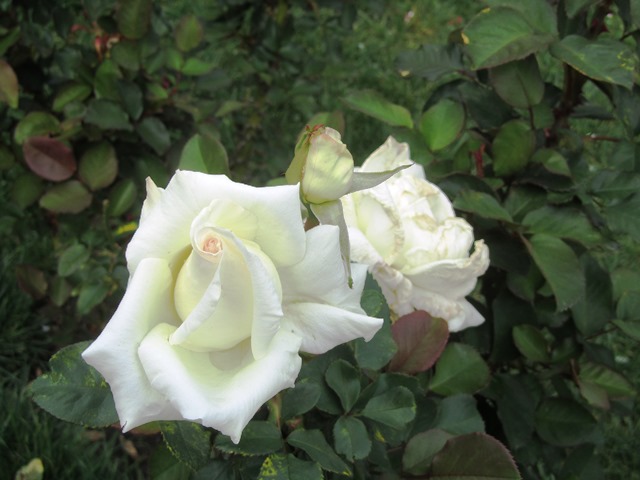
If you enjoy reading about gardening and country living and also love a good story, check out my Henny Penny Farmette series of cozy mysteries. All are available online and wherever books are sold. They include, A BEELINE TO MURDER, THE MURDER OF A QUEEN BEE, and A HIVE OF HOMICIDES.
Propagating Plants from Rose Cuttings
Roses are among the most romantic flowers in a garden. I grow dozens of cultivars of rose bushes–climbers, hybrid teas, floribundas, and polyanthas. When I have an extra few dollars, I might spend it on a rose bush, but when money is tight, I simply start a new bush from one of my favorites that I’m currently growing.
My husband and I love the climbers. We have tall fences (over six feet) around our property on all sides. Covering an entire fence is easy when you use a vigorous, virtually pest-free climber. Two roses that quickly adapt and grow to fantastic heights are Sally Holmes and Cecile Brunner.
Climbing roses need strong support, since some canes can reach forty feet or more as they scramble over a roof or stone wall, trellis, fence, or arbor.
Last year, my husband created a rose arbor on wires strung from the fence along the north side of our house to the roof line. He planted the Cecile Brunner rose as his climber of choice. Its sage green leaves make a lovely foil for the tiny pink roses that permeate the air with a spicy-sweet scent throughout the spring. Cutting and feeding will render another bloom in summer.
My garden has plenty of places where I could tuck in a new rose bush, and I’ve bought many over the years. I have some favorites that I’d like to start in other areas. They include A Shropshire Lad, Handel, Lady Banks (a thornless yellow rose), and Iceberg.
This is the perfect time to propagate roses from cuttings in the Bay Area since the rose bushes in many yards are beginning to awaken. Roses require water, something no longer plentiful in California. Thanks to a severe four-year drought, we now have mandatory water restrictions. That means we gardeners must consider how we can recycle water, use gray water, collect water, and otherwise find ways to reduce water usage.
To propagate a rose from your favorite bush, take a six-inch cutting from a healthy cane. Make the bottom cut a sharp angle cut, not straight across. Do not crush the stem. Remove the leaves.
Dip the angle cut into a jar of root hormone powder. This powder enables the cane to root more easily in the ground or pot.
Insert the prepared cutting in the soil. Water as needed when the soil is dry. The cutting will need one to two months to root and then, it will begin to leaf out.
Some people like to put a quart jar over their cutting to create a mini-green house climate. In mild climates like the Bay Area, this isn’t necessary. The best time to propagate cuttings from your favorite roses is in the spring and never in extremes of cold or heat.
Creating romance in the garden could start with a table and chairs, floral-motif linens, and a service of tea. But even before those accoutrements to romance are added, why not fill the space with roses? It’s so easy.
 Facebook
Facebook Goodreads
Goodreads LinkedIn
LinkedIn Meera Lester
Meera Lester Twitter
Twitter




